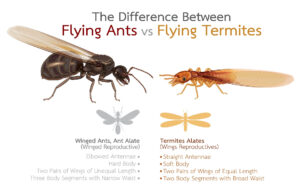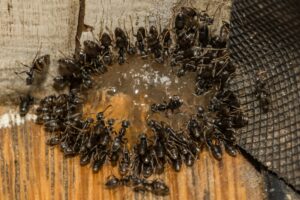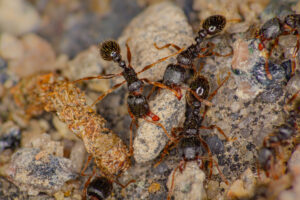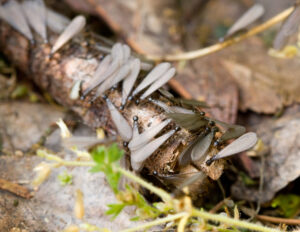Late Winter, Early Spring Ants and Termites
By Zachary Ciras on March 27, 2025.
Ants in New England Homes: A Late Winter Surprise

As the chill of late winter lingers in New England, homeowners might expect their homes to remain quiet sanctuaries from the bustling outdoor world. However, February often brings an unexpected visitor: ants. Even with snow still blanketing the ground, these tiny invaders can make their way indoors, drawn by warmth, moisture, and the promise of food. For residents of Massachusetts and New Hampshire, this phenomenon is all too familiar. Among the culprits are carpenter ants, odorous house ants, pavement ants, citronella ants (also known as large yellow ants), and even termite swarmers, which can be mistaken for ants. Understanding these pests and how to prevent them is key to keeping your home pest-free.
Carpenter Ants: The Silent Destroyers
Carpenter ants are among the most concerning late-winter intruders. These large, black ants don’t eat wood like termites but excavate it to build their nests, potentially causing structural damage over time. In late winter, they may emerge indoors as they seek warmth or moisture from damp wood in basements, attics, or near leaky pipes. Signs of carpenter ants include small piles of sawdust-like frass or faint rustling sounds in walls.
**Prevention Tip:**
Seal cracks around doors, windows, and foundations. Keep firewood stacked away from the house and address any moisture issues, like leaks or poor ventilation, promptly.
Odorous House Ants: The Smelly Scavengers
 Odorous house ants are small, dark brown ants notorious for their rotten coconut-like smell when crushed. These pests form trails as they forage for sweets, grease, or crumbs, often invading kitchens or pantries. In late winter, they may venture indoors from outdoor colonies or establish satellite nests in wall voids near heat sources.
Odorous house ants are small, dark brown ants notorious for their rotten coconut-like smell when crushed. These pests form trails as they forage for sweets, grease, or crumbs, often invading kitchens or pantries. In late winter, they may venture indoors from outdoor colonies or establish satellite nests in wall voids near heat sources.
**Prevention Tip:**
Store food in sealed containers, wipe down surfaces to remove crumbs, and use caulk to seal entry points like gaps around pipes or wires.
Pavement Ants: The Sidewalk Settlers
Pavement ants are tiny, dark ants often found near driveways or sidewalks, but they’ll happily march indoors when temperatures drop. They’re attracted to a variety of foods, from pet kibble to sugary spills. You might spot them trailing along baseboards or countertops in late winter as they seek shelter and sustenance.
**Prevention Tip:**
Sweep up debris near exterior entryways and keep trash cans tightly sealed. A quick vacuum of stray ants can disrupt their trails before they settle in.
Citronella Ants: The Yellow Surprise
Citronella ants, also called large yellow ants, are less common but can startle homeowners with their bright yellow color and distinct lemony odor when disturbed. These ants often swarm in late winter or early spring, emerging from soil-based nests. While they don’t typically invade homes for food, their swarming behavior indoors can signal a nearby colony.
**Prevention Tip:**
Check for soil contact with siding or foundations and maintain a barrier of mulch or gravel to deter nesting near your home.
Termite Swarmers: The Ant Impostors
Termite swarmers are often confused with ants due to their winged appearance in late winter or spring. Unlike ants, termites have straight antennae and no pinched waist. Seeing them indoors could indicate an established colony, posing a serious threat to wooden structures.
**Prevention Tip:**
Schedule a professional inspection if you spot swarmers, as early detection is critical to preventing costly damage.
Colonial Pest Control: Your New England Ally
For over 40 years, Colonial Pest Control has been a trusted name in Massachusetts and New Hampshire, protecting over 14,000 homes with our semi-annual preventative maintenance program. Our highly trained technicians understand the unique pest challenges of New England winters and approach every job with care, respecting your home and family. Whether it’s ants or termites, we’ve got you covered with tailored solutions.
One of our standout offerings is the Sentricon Termite Colony Elimination System, a best-in-class solution for termite control. Unlike traditional methods that involve drilling into your home or yard, Sentricon uses discreet, safe stations placed around your property. These stations contain Recruit HD bait, a highly effective termite-specific formula that termites carry back to their colony, eliminating it at the source. The system requires no disruption to your home, making it ideal for households with kids and pets. It’s a proactive, environmentally conscious approach that gives homeowners peace of mind without the mess.
General Prevention for Late Winter Ants
Beyond species-specific tips, a few universal strategies can keep ants at bay:
– Maintain Cleanliness: Regularly clean floors, counters, and pet bowls to eliminate food sources.
– Seal Entry Points: Use weatherstripping and caulk to block cracks and crevices.
– Monitor Moisture: Fix leaks and use dehumidifiers in damp areas like basements.
– Trim Vegetation: Keep branches and shrubs away from your home’s exterior to reduce pest highways.
When to Call the Pros
While DIY methods can help, persistent or large-scale infestations often require expert intervention. Carpenter ants and termites, in particular, can cause hidden damage that’s hard to spot until it’s too late. Colonial Pest Control’s technicians are equipped with the latest tools and knowledge to tackle even the toughest pest problems, ensuring your home stays safe and sound.
As February winds down, don’t let ants or termites catch you off guard. With a little vigilance and the right support, you can enjoy the tail end of winter without uninvited guests. For New England homeowners, Colonial Pest Control is just a call away—bringing decades of experience and cutting-edge solutions like Sentricon to your doorstep.